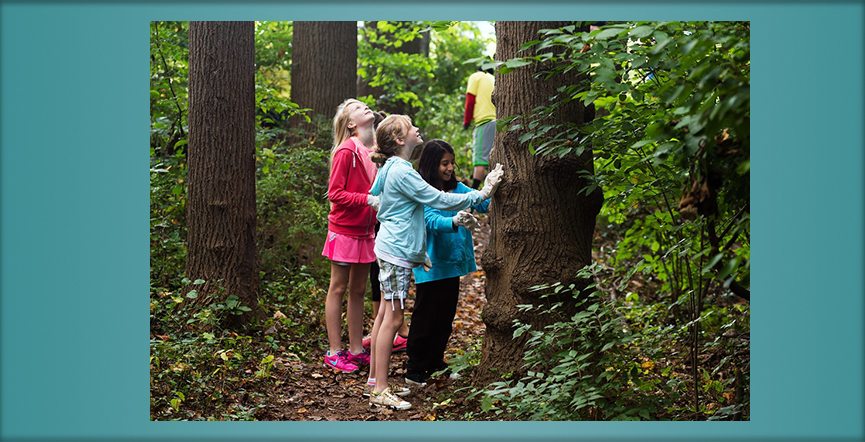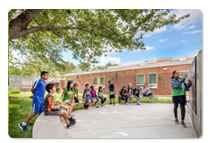Getting Started Teaching Outside
Why take students outside?
Young people who lack a connection to the natural world right outside their door exhibit signs of “nature-deficit disorder.” This term, first used in Richard Louv’s book Last Child in the Woods, describes the effects of a disengagement with the natural world to many trends commonly seen in young people, including obesity, attention disorders, stress, anxiety, and depression. A growing body of research is showing that time spent exploring and learning in a natural environment has tremendous benefits for students. These benefits include boosted student academic achievement, improved student problem solving and critical thinking skills, and reduced student stress levels.
Not only does outdoor learning benefit students, but it can have profound impacts on communities as well. Many schools in FCPS, particularly those with native habitats or edible gardens, host a nature day, planting or cleanup day, or other environmental events for the school community. Spending time together outside in a shared experience allows communities to bond while positively impacting their environment.

Where Can I Find Research on the Benefits of Engaging with Nature?
If you are looking for more research and data on the benefits and outcomes of young people spending more time in nature, the easiest place to find research that fits your needs is the Children and Nature Network’s Research Library. It provides a searchable tool to find peer-reviewed scientific research that provides evidence for the benefits of connecting children and adolescents with nature.
How to Get Started Teaching Outside
Learning outside can be a daunting task, but easing into outdoor learning makes it easier. Follow Get2Green’s tips for taking students outside to help you get started.
-
Safety first! Before taking students to an outdoor area, take a quick walk through the area to check for unforeseen dangers or distractions. Such items may include: unusual trash items left behind, workmen in the area, flooded or muddy pathways, poison ivy, etc.
-
Being uncomfortable is a big distraction. Address comfort issues immediately so students don’t need to worry about it. If you are going to be in the hot sun or in the cold for a short time, let them know so they are not fretting about it while you are talking. Do your best to have students dress appropriately for the weather before going outside. Try to be oriented so the sun is in your eyes and not in theirs. If you will be out for a long time, or in a remote location, make sure students are informed of the bathroom and eating plans. Getting a little dirty is okay!
-
Use transition points to keep the group focused. Stop at points like the classroom door, the door leaving the building, the end of the sidewalk, and the beginning of the trail to pull the group together and remind the students what it is they will need to accomplish outside, where they are going, who is the leader of the group, etc.
-
Address fears the group has up front. Fears can be distractions too if not addressed. Even in urban areas, students may be afraid of the woods or think that there are large animals such as bears. More often, encountering a bee, tick, or mosquito will be the concern. Know that most bees are gentle rather than aggressive and will not sting unless provoked. Many bees do not sting at all.
-
Open spaces and hills are unspoken invitations to students. Open spaces say “run” to children and some adults, and hills say “roll down me.” Decide ahead of time how you want to use these spaces and be very clear with students. Sometimes allowing students to run across an open field to a trailhead helps them settle down to learn. Rolling down a hill is a sensory experience kids love, but the hill may be wet, have rocks, etc. that may not make that activity the best idea.
-
Take the unplanned in stride. Inevitably, your study of birds will be interrupted by a sighting of the first monarch of the season, a flower blossom, an insect, etc. Always plan a few extra minutes to take advantage of these teachable moments and times of wonder at nature. Address the student interest in these objects or they will be a continued distraction.
-
Bring a little notebook or whiteboard. Bring something along where you or a student can keep a list of questions or observations that you might want to take more time on later. As mentioned in number 5, your budding naturalists will always notice something else to talk about. Writing it down makes students that are interested comfortable to return to the main topic and to work on answering these follow up questions later.
-
Get down to eye level. If you’re working with younger students, crouch down to their level when showing them something or talking to them. It is often easier for larger groups to see what you are doing and to hear you. Vary your voice when outside to hold their attention.
-
Have something in your pocket. So you left time for the unplanned but ended up with a few extra minutes and 30 students to keep engaged. Keep some multicolored paint chips from a home improvement store and match them to the foliage, bark, or soil. Students often think of nature as green or brown, but nature’s color palette is far more complex than that.
-
Let the students be the naturalists. Students will often spot something that you walk right past. Give them some time to look for “cool” things or make sure they know they can point out items or other observations they spot along the way.
-
Don’t be afraid to not have an answer. If a question is asked and you don’t know the answer, add it to your list from number 7. Even seasoned naturalists don’t know every area of outdoor study. If someone wants to know the name of a plant, have the group come up with its own common name for the plant. That common name is just as good as one of the other many common names for that plant and many times will actually be one already in use.
-
Water is always a distraction. Whether it is a puddle, pond, or lake, people are drawn to water. Know that if you pass it by, students may continue to be distracted by it.
-
Have fun and go outside again! Enjoy the wonder of the outdoors. It may take a few lessons outside with a class before students settle in and realize that going outside is stepping into an outdoor classroom. It is not always recess or break when students pass beyond the school doors. Just as students learn good hallway behavior, good outdoor behavior must be learned as well.
Additional Resources for Teaching Outside
Find additional resources for teaching outside.


